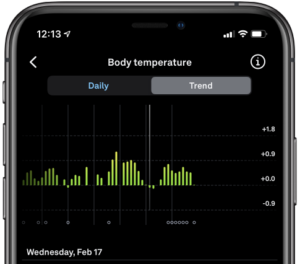The term “body temperature” is often used to describe methods of measuring temperature interchangeably without clarifying that different measurement sites yield different readings. Your body is typically divided into two regions—your core and your shell (including your skin and extremities).
Your body is always trying to maintain an ideal temperature range in your core, which means it prioritizes stabilizing your internal temperature. The range of your shell, on the other hand, fluctuates more widely.
For example, your core body temperature might be relatively stable while your skin temperature changes based on your environment and your body’s internal adjustments to make you warmer or colder.
As a result, the location where you measure your temperature is key. Are you trying to capture your core body temperature, or temperature fluctuations in your shell? Regardless of where you measure, be sure to remain consistent.
READ MORE: How Oura Measures Body Temperature
Your Shell Shows More Temperature Variation
Your core body temperature is the clinical standard. It’s what doctors measure when checking for fertility or infection. However, outside a doctor’s office or lab, its most common measurement sites (e.g., mouth, armpit, or rectum) can lack practicality, especially for continuous measurements.
On the other hand, your shell temperature is less invasive to measure and can provide insights on the same rhythms as core temperature—menstrual cycles, daily fluctuations, circadian rhythms, etc.—as well as other health indicators like a fever. Your shell temperature can be measured from easily accessible external locations like your forehead or hands.
New research shows that shell temperature can even carry more information than core temperature due to your body’s insulation—resulting in limited changes in core temperature. Your shell exhibits frequent, and more significant, changes in your skin temperature, while core changes can be more muffled. Shell temperature represents a unique opportunity to capture information about subtle or rapid changes in temperature.
With this in mind, Oura measures body temperature directly from the skin of your finger, picking up on these subtle variations and providing a comfortable, easy way to continuously measure your temperature without disrupting your routine.
The temperature sensor can detect changes as small as 0.1° Celsius.
It Can Change Independently or With Your Core Temperature

Your body is constantly adjusting to keep up with how your external environment and internal changes influence your core temperature. One of your body’s strongest tools is using blood to move heat to or from your core—helping maintain your ideal temperature.
As a result, sometimes your shell and core temperature move together, while other times they move in opposite directions.
Your shell often indicates what’s happening inside your core. For example, if your body tries to cool itself before bed, your core temperature will decrease as your skin temperature goes up—a sign of heat being vented through your extremities. The opposite is true as well—if you head outside in the winter and find that your fingers and toes get cold first, your body is trying to control its core temperature by pulling heat to your center.
Other times, your core and shell temperature will change together. For example, they may both rise in the presence of a fever or after ovulation.
READ MORE: How to Use Oura Temperature Trends to Track Your Cycle
How Does Oura Measure Temperature?

Oura prioritizes accuracy when it reads and reports your temperature:
- Direct Skin Temperature: Oura is one of the few wearables that continuously measures body temperature directly from your skin rather than estimating it using your external environment. At night, your skin temperature is closely related to your internal temperature and does not require an invasive thermometer to read. This allows for continuous monitoring each night, without disrupting the user’s lifestyle.
- Relative Values: Oura shows your body temperature in relation to your personal baseline. For example, rather than display your temperature as 36.5 °C / 99.5 °F, Oura will show how much higher or lower your temperature is compared to your baseline (+0.1 °C/°F).
- Strain vs. Recovery: To provide you with meaningful insights, Oura exclusively reports your nighttime body temperature. Body temperature is a well-regulated body measurement that can influence daytime habits. As a result, measuring at night is the best way to keep conditions stable to reveal your body’s recovery status.
- Sampling Rate: Every minute, Oura’s temperature sensor measures your skin temperature. Our algorithm selects values that are most likely to correlate with core body temperature and averages across those data points to provide you with a single value that best represents your night.
RELATED: Understanding the Normal Fluctuations in Body Temperature










